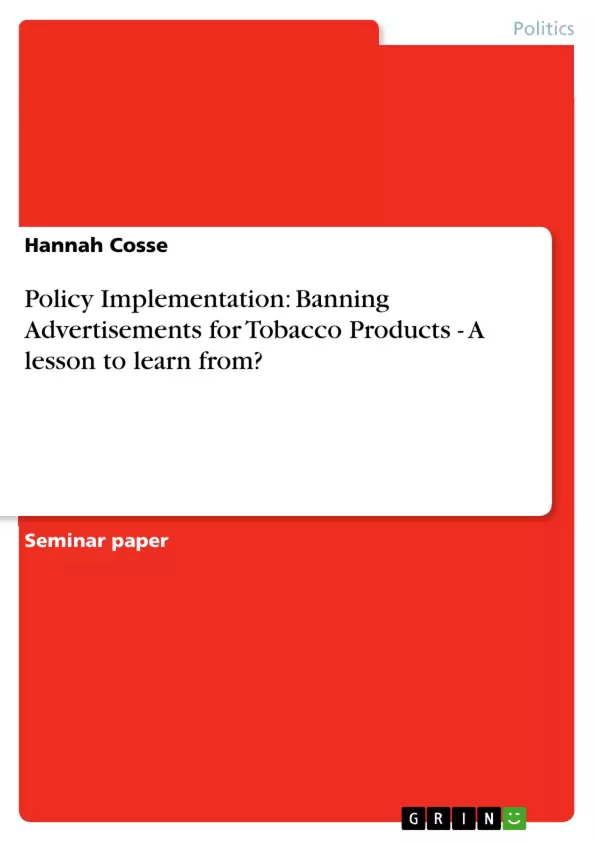Alleged 55 million adults in the European Union drink at harmful levels. Undoubtedly abuse of alcohol is insanitary. Therefore the European Commission set out a strategy in October 2006 to reduce the numbers of drinkers. Among the measures is a recommendation to ban advertisements for alcohol. Drinking is unhealthy - so is smoking. Thus the Tobacco Advertising Directive is finally implemented in the summer of this year by the last member states. But the story of this achievement reaches back nearly a decade: due to implementation deficits the process of banning advertisements for tobacco products cannot be regarded as a fast and efficient process. It started in 2003 when finally the directive 2003/33/EC was passed by the Council and the European Parliament that prohibits any kind of advertising for tobacco products in print, internet and online media. It should have been implemented by each member state until the 31stof July 2005. But two countries - Luxembourg and Germany - failed to implement up to that date. Germany sued the Commission, because they argued that the directive exceeded its legal base concerned with the internal market and competition rules. Those were the reasons the Commission had claimed to justify its directive. Germany took the directive to the ECJ, and the Commission - as the last step of the infringement procedure - sued Germany for not implementing. While both cases were pending the German government finally agreed to implement the directive in July 2006 - but only at the time where it was quite likely that they would loose their case at the court.
In total it took the Commission nearly ten years to achieve their aim. Now, with the discussion about banning advertisements for alcohol a similar process starts again. If the Commission could or should learn something from its former experience is the question that should be answered in this paper.
In the second part of this introduction necessary remarks about lesson drawing in general will be made. A vital part for lesson drawing is - obviously - a similarity between the two cases that shall be compared. That this applies to the chosen examples will be shown in the first part after the introduction. Furthermore in this second part of the paper the emergence of the Tobacco Advertising Directive will be shown. A model will be developed that describes the real-life deficits of the implementation process.
Inhaltsverzeichnis (Table of Contents)
- I. Introduction
- II. Two unhealthy Habits
- II.1. Alcohol Abuse in the European Union
- II.2. The Tobacco Advertising Directive
- II.2.a. Tobacco Consumption in the European Union
- II.2.b. The Emergence of the Ban
- II.2.c. Results: The Problems of the Ban
- III. Policy Implementation
- III.1. The Theoretical Problem
- III.2. The Structural Problem: Infringement Procedure
- III.3. Results: Inherent Problems of Implementation
- IV. Drawing a Lesson: Problems to avoid!
- IV.1. A multiplicity of interests: Tobacco Lobbying
- IV.2. Learning a Lesson?
- V. Conclusion
- List of References:
- Annexes:
- Annex 1: Legal Documents concerned with tobacco consumption
- Annex 2: Advertising Bans
- Annex 3: Tobacco advertising ban - decision-making process
- Annex 4 Tobacco Companies
Zielsetzung und Themenschwerpunkte (Objectives and Key Themes)
This paper aims to analyze the Tobacco Advertising Directive as a case study to draw lessons for the European Commission's current efforts to ban alcohol advertisements. The paper explores the challenges and complexities of policy implementation in the European Union, focusing on the specific case of the tobacco advertising ban. The key themes of the paper include:
- Policy implementation in the European Union
- The effectiveness of advertising bans in reducing harmful consumption
- The role of the Tobacco Advertising Directive as a lesson for future policy initiatives
- The influence of lobbying on policy implementation
- The importance of considering structural and theoretical challenges in policy implementation
Zusammenfassung der Kapitel (Chapter Summaries)
The paper begins by introducing the challenges of reducing alcohol consumption in the European Union and the Tobacco Advertising Directive, highlighting the long and complex process of its implementation. The second chapter examines the Directive in detail, analyzing the emergence of the ban, the challenges faced, and the results of its implementation.
The third chapter explores the theoretical and structural problems of policy implementation in the European Union, using the Tobacco Advertising Directive as a case study. This chapter provides an in-depth analysis of the implementation process, including its inherent problems and the challenges faced by the European Commission. The final chapter draws lessons from the case study, focusing on the challenges that the Commission should be aware of when considering banning alcohol advertisements. The chapter provides recommendations based on the insights gained from the Tobacco Advertising Directive experience.
Schlüsselwörter (Keywords)
This paper focuses on the implementation of policy in the European Union, specifically the Tobacco Advertising Directive and its relevance as a lesson for future policy initiatives. Key concepts include policy implementation, advertising bans, public health, tobacco consumption, alcohol consumption, lobbying, and the European Commission.
- Citation du texte
- Hannah Cosse (Auteur), 2006, Policy Implementation: Banning Advertisements for Tobacco Products - A lesson to learn from?, Munich, GRIN Verlag, https://www.grin.com/document/70290



